HLS vs RTMP - dry statistics
If someone decided to do the processing, storage and transfer of video for their online project on their own, rather than using sites like YouTube, he inevitably comes to the question of which transfer protocol to use to broadcast video to users ’devices. The choice is small, because There are a number of industry standards that support certain devices. In addition, the choice of protocol largely depends on the “class” of the video — live broadcast or video-on-demand. The choice of media server, which will be the engine of your media machine, also depends on the choice of protocol: will you install several heterogeneous servers or build a delivery network on one solution? Therefore, you need to weigh everything and make a decision based on the criteria of your business.
In general, an equation with many unknowns is obtained. The dynamics of the process are important here - but where is the industry going? Suddenly, I will invest in technology support, and it will fold in a year, because this has already happened. Or put on fashionable technology, but no one supports it?
We decided to evaluate how the proportion of different protocols changed over time - to look at the dynamics of the whole process. Data taken over the past year.
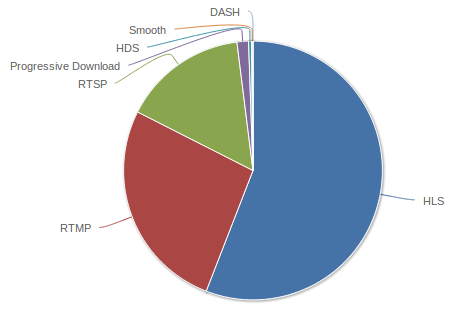
To begin with - who are we to judge market shares? We are the developers of a reporting web service for media servers . We have been working on the market for the fourth year and companies with different infrastructures, a different number of servers and different needs come to us. It turns out a good cast of the state of the industry.
We made a small report where you can select a date range and receive data with a graph according to the number of video views through various protocols.
The report provides data on the servers:
At the time of writing, the service serves about 1000 servers from 60 countries.
The report is also periodically updated in our blog, it is available by the corresponding tag .
The June / July 2014 report looks something like this. Of the 1.4 billion views, more than half are HLS. In second place is RTMP with a quarter of views. RTSP is about one sixth. The rest are in the area of statistical error.
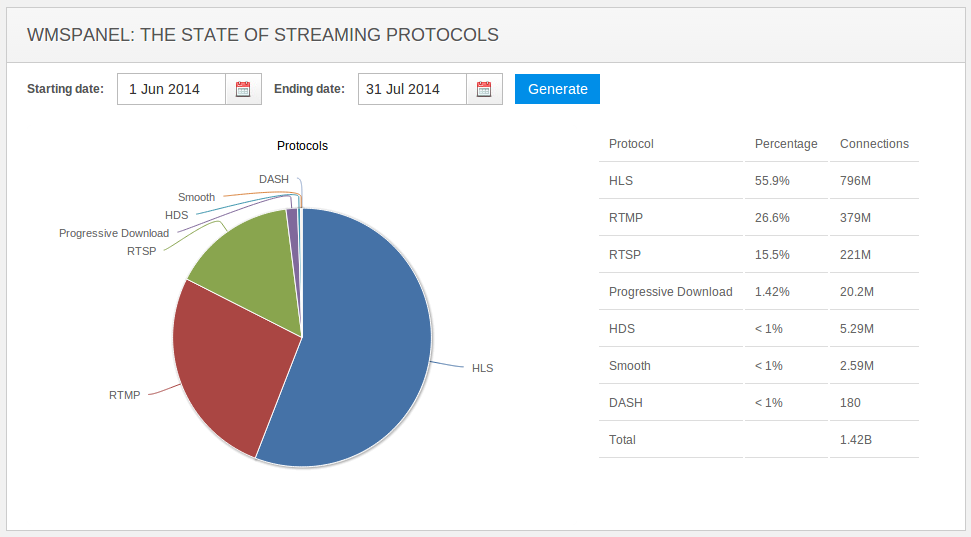
What was a year ago during the same period? The situation is almost a mirror. RTMP - almost two-thirds, RTSP and HLS share second and third places. True, the measurement base was almost 3 times smaller - “only” 500 million views . The servers in our service were also smaller, of course.

Let's walk between these two points.
So, June - August 2014, 3 months of the summer. 800 million views , but the shares are the same; August brought no changes.
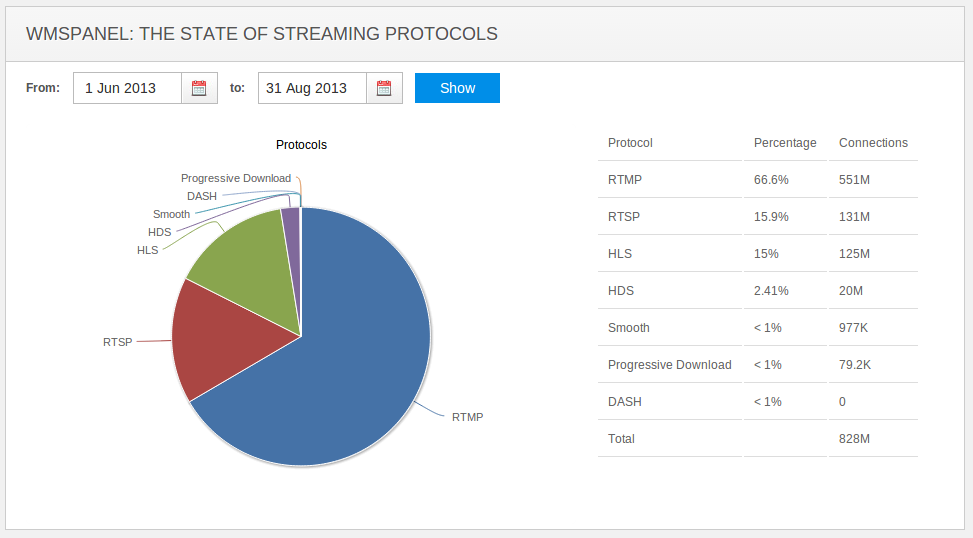
September - November 2013. A new season began, HLS began to eat up the share of RTMP. Only 1.1 billion views , RTMP has about half of the total, HLS is a quarter.
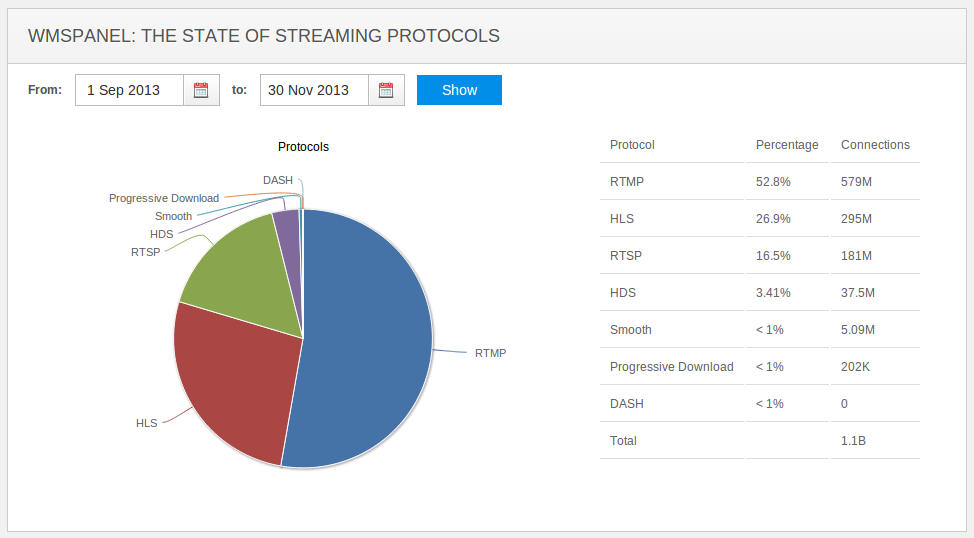
December 2013 - February 2014. 1.4 billion views , of which more than 40% fall on HLS. RTMP and RTMP share second and third place with a quarter share. The Sochi Olympics gave an increase in the number of views and at the same time forced providers to remember all the clients with all their exotic or old devices that only understand RTSP — hence the leap of this protocol.

March - May 2014. 1.9 billion views and HLS is already the undisputed leader with more than half the market. RTMP confidently holds a quarter, the rest took those shares that we saw in the first diagram.
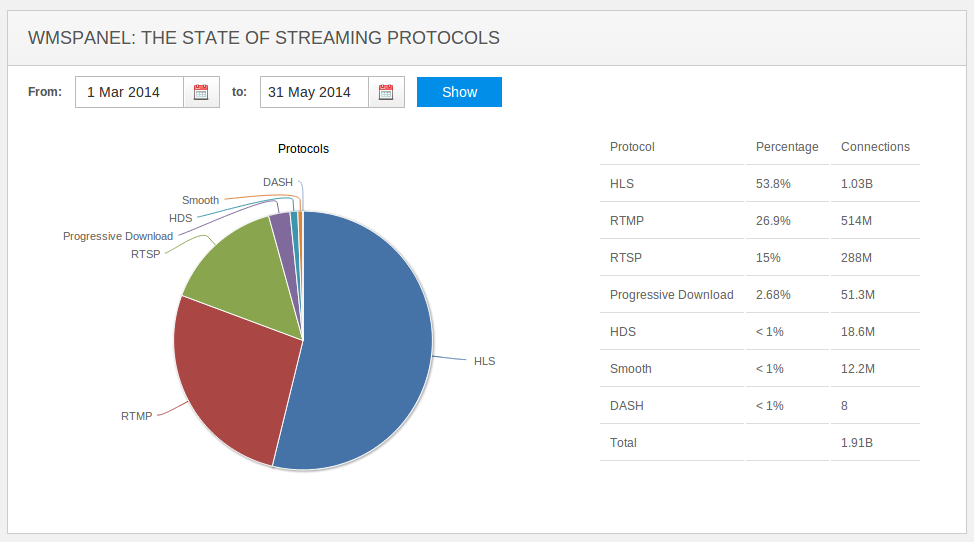
HLS ( HTTP Live Streaming ) today has become the de facto standard in the world of video streaming for consumer devices. Originally made for the devices of one fruit company, it quickly gained popularity on other devices - desktops, STB, as well as Androids - starting with version 4, they began to understand this protocol.
RTMPremains indispensable where data transfer is required close to real time. HLS gives some delay in connection to download the first data chunk, and in the case of RTMP, mapping starts almost immediately. In general, this is the most advanced real-time media transfer protocol, despite all the ambiguities in implementation (each new vendor adds its own peculiarities), more time-consuming deployment and scaling with respect to HLS.
RTSP is still used as fallback for old Androids.
I would also like to say about MPEG-DASH- despite all the efforts of the industry, the transition to it occurs with a creak. Of course, sooner or later there will be a smooth transition from all HTTP-based protocols - HLS, HDS, SmoothStreaming - to it, but so far these are just plans.
The share of the Progressive download , on which video works on a considerable number of sites, is also interesting . Technically very simple, it allows you to start distributing video-on-demand almost without any special media servers. Since Vovza does not work on this protocol, its share became possible to track only as our Nimble Streamer was installedto the client server. The current 20M + views for 2 months of the summer is not the limit, and the actual share of this protocol is definitely higher. Although, he has limitations that leave him a relatively small niche.
If you have questions about data collection or interpretation, ask.
PS Who is interested in other observations from the world of online media - also read my materials on Geektimes .
In general, an equation with many unknowns is obtained. The dynamics of the process are important here - but where is the industry going? Suddenly, I will invest in technology support, and it will fold in a year, because this has already happened. Or put on fashionable technology, but no one supports it?
We decided to evaluate how the proportion of different protocols changed over time - to look at the dynamics of the whole process. Data taken over the past year.

Initial data
To begin with - who are we to judge market shares? We are the developers of a reporting web service for media servers . We have been working on the market for the fourth year and companies with different infrastructures, a different number of servers and different needs come to us. It turns out a good cast of the state of the industry.
We made a small report where you can select a date range and receive data with a graph according to the number of video views through various protocols.
The report provides data on the servers:
- Wowza Streaming Engine in all versions from 2.2 to the latest 4.x; most of them are 3.x.
- Nimble Streamer working with HLS, Smooth, HDS and progressive download is our development.
- Windows Media Services - there are literally a couple of dozen of them, but they are, and we must take them into account
At the time of writing, the service serves about 1000 servers from 60 countries.
The report is also periodically updated in our blog, it is available by the corresponding tag .
Go
The June / July 2014 report looks something like this. Of the 1.4 billion views, more than half are HLS. In second place is RTMP with a quarter of views. RTSP is about one sixth. The rest are in the area of statistical error.

What was a year ago during the same period? The situation is almost a mirror. RTMP - almost two-thirds, RTSP and HLS share second and third places. True, the measurement base was almost 3 times smaller - “only” 500 million views . The servers in our service were also smaller, of course.

Let's walk between these two points.
So, June - August 2014, 3 months of the summer. 800 million views , but the shares are the same; August brought no changes.

September - November 2013. A new season began, HLS began to eat up the share of RTMP. Only 1.1 billion views , RTMP has about half of the total, HLS is a quarter.

December 2013 - February 2014. 1.4 billion views , of which more than 40% fall on HLS. RTMP and RTMP share second and third place with a quarter share. The Sochi Olympics gave an increase in the number of views and at the same time forced providers to remember all the clients with all their exotic or old devices that only understand RTSP — hence the leap of this protocol.

March - May 2014. 1.9 billion views and HLS is already the undisputed leader with more than half the market. RTMP confidently holds a quarter, the rest took those shares that we saw in the first diagram.

How to understand all this?
HLS ( HTTP Live Streaming ) today has become the de facto standard in the world of video streaming for consumer devices. Originally made for the devices of one fruit company, it quickly gained popularity on other devices - desktops, STB, as well as Androids - starting with version 4, they began to understand this protocol.
RTMPremains indispensable where data transfer is required close to real time. HLS gives some delay in connection to download the first data chunk, and in the case of RTMP, mapping starts almost immediately. In general, this is the most advanced real-time media transfer protocol, despite all the ambiguities in implementation (each new vendor adds its own peculiarities), more time-consuming deployment and scaling with respect to HLS.
RTSP is still used as fallback for old Androids.
I would also like to say about MPEG-DASH- despite all the efforts of the industry, the transition to it occurs with a creak. Of course, sooner or later there will be a smooth transition from all HTTP-based protocols - HLS, HDS, SmoothStreaming - to it, but so far these are just plans.
The share of the Progressive download , on which video works on a considerable number of sites, is also interesting . Technically very simple, it allows you to start distributing video-on-demand almost without any special media servers. Since Vovza does not work on this protocol, its share became possible to track only as our Nimble Streamer was installedto the client server. The current 20M + views for 2 months of the summer is not the limit, and the actual share of this protocol is definitely higher. Although, he has limitations that leave him a relatively small niche.
If you have questions about data collection or interpretation, ask.
PS Who is interested in other observations from the world of online media - also read my materials on Geektimes .
